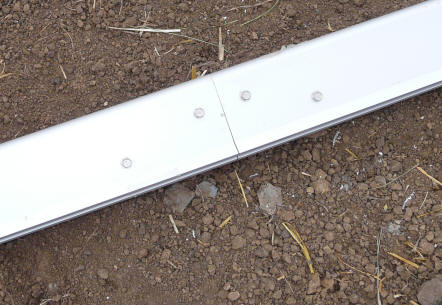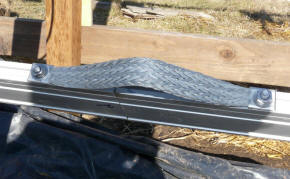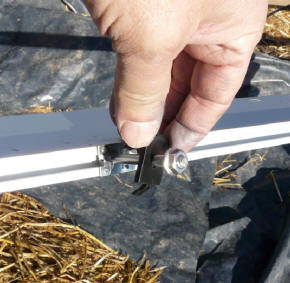
Search
The Renewable Energy site for Do-It-Yourselfers
DIY PV System --
Mounting the Components
Back to the PV
System page...
This page covers installing the
rails, the PV panels, and the micro-interters.
Installing the Rails
Once the mount frames are in place,
the aluminum rails can be mounted. The rails in turn allow easy
installation of the PV panels and inverters.
In our case, the rails were provided
by IronRidge.

The IronRidge PV mounting rail.
The "L" bracket holds the rail down to the 4X4 mounts.
The back clamp in the top slot fits between two PV modules and clamps them to
the rail.
The near clamp is the one used on the end modules.
The IronRidge rail is pictured above.
The "L" bracket attaches the rail to
the 4X4 mount frame, and attaches to the rail via the lower slot in the vertical
face of the rail.
The head of a 3/8 inch bolt slides
into this slot allow the L brackets to be positioned anywhere along the rail.
The holes are slotted to allow for a little adjustment.
The black bracket in the top slot is
a hold down for a PV panel mounted in the end position.
A 1/4 inch bolt head slides into the
top slot to allow the end clamp to be installed anywhere along the rail.
The longer bolt and clamp in the
upper slot toward the back of the picture is the clamp that goes between two PV
panels to hold both of them down.
The clamps used must match the brand
and style of PV panel you want to mount, but a wide variety of clamps are
available.
This is a nice system and saves a lot
of time in the mounting process. Other manufacturers make similar rail
mounting systems -- Unirac
is another popular brand.
The first step is to splice the rail
sections together to make two rails, each long enough to mount all 10 panels
(about 33 ft).
A finished splice is shown just
below. A 12 inch long extruded section that just fits the inside of the
rail is slid into each of the rails to be spliced. The splice is secured
with 4 self tapping screws. This makes a nice strong joint, and is very
easy to do.

A rail splice. An extruded splice fitting extends 6 inches
into each of the
two rail sections that are being spliced.
Four self tapping
stainless screws are then used to secure the splice.
I decided to let the
rails run a few inches long on each end, and to delay trimming them to exact
length until the panels were mounted -- I did not quite trust myself to measure
twice and cut once at this stage :)
The mount rails are
then installed on the angled 4X4's using the IronRidge provided "L" brackets.
Stainless steel bolts are included to mount the rail to the L bracket. I
used 3/8 inch galvanized bolts to bolt the L brackets to through the 4X4's.
The holes in the L bracket are slotted to allow a little room for adjustment.
All the fasteners are left loose, and the rail is adjusted until it is straight
from end to end. Then all the fasteners are tightened. IronRidge
provides torque settings for all the bolts, and I used a torque wrench to do the
tightening.
Some of the treated
wood literature recommends against having aluminum in direct contact with the
treated wood, so I painted the bottom of bracket and top of frame to avoid (or
at least reduce) direct contact.
click pictures for
full size
|
 |

Rail attached to wood frame with
"L" bracket. |
Note that the head
of the bolts that attach the rail to the L bracket slide in slots in the rail.
This kind of slide the bolt head into a slot is used to for all of the equipment
connected to the rail. It makes for nice easy attachments, as the rail
slot fits over the bolt head flats and does not allow the bolt to turn as the
nut is tightened.

Rails mounted.
Attaching equipment
to the rails
It is important at
this point to figure out exactly what equipment will be attached to the rails.
In our case, this included 1) the PV panels, 2) the micro-inverters, and 3) the
grounding straps that insure continuous ground at the rail splices. You
need to work out exactly what sequence of bolts will be needed along the rail,
and then slide the bolt heads into the rail slot in the right order. If
you forget about a bolt that will be needed in the middle of the rail, you will
have to slide all the bolts to one side of it out in order to get the missed
bolt in.

This shows a view along the top rail with the bolts slid into place. The
long bolts hold the
panels down. The pairs close together hold the micro-inverters down.
There are bolts that don't show
that hold each end of the ground strap at rail splices (see below).
Be sure to double
check that you have all the bolts in the right positions before you start
installing hardware on the rails.
Keeping Things
Straight
With all the
different things being attached to the rails, there is a lot of hardware to keep
straight. I took all the nuts, bolts, and washers out of their
packaging, and placed them in cut away gallon milk jugs. For example, all
the hardware needed to connect micro inverters to the rail goes in one jug, all
the hardware needed to secure a mid array PV panel to the rail goes in another
jug. Through some combination of this system and blind luck, I never lost
a needed part during the installation.

Mounting the Micro-Inverters
The first thing to go on for our
system was the Enphase micro-inverters. On our system, these inverters got
mounted to the top rail, as this provided good access to the wires coming from
the PV panel junction box to the inverter. To mount the inverters, mark
the center of each of the PV panels on the rail, so you know about where each inverter will
go.
Mount the micro-inverters starting
with the one that will be nearest the junction box that will carry the PV power
to the house.
Orient the micro-inverter so that its
AC output (male) connector is toward the junction box. The inverter can be
mounted with either side up to get the cord pointed the right way.
I mounted the inverters using 1/4
inch stainless bolts about 1 inch long. I used a large flat stainless
washer, and then a stainless lock washer, and then the stainless nut to secure
inverter. Torque the nut to the recommended torque.
If you are using the Weeb Washer
grounding system (see below), then the proper Weeb washer needs to be inserted
over one of the bolts and between the rail and the inverter. I used the
Weeb washer grounding system for the PV panels and the rail splices but did not
use them for the inverters, and ran a separate ground wire (see below) instead.
I would say that the Weeb washers would have been easier, and no more expensive,
and I would recommend using them to ground the inverters to the rail.
Note that at this point, if you are
doing a roof mount, you will probably want to connect the PV panel wire to the inverter,
and connect the inverter output AC wire to the next inverter. For the
ground mount system, you can do all this wiring later at one time, but for the
roof mount, you won't have easy access to the back of the PV panel once its down.
Guy shows the way to do it for a roof mount.
Click on pictures for full size
|

Installing inverter with torque wrench. |

The inverter installed.
Note the rail splice and ground
strap that insures the two rail segments
are electrically bonded together just to the right
of the inverter. |
At this point its probably a good
idea to peel one of the serial number stickers off the inverter, and put it on
the inverter map in the right position (see below) -- its easier to get at the
stickers now then after the PV panels are installed.
Do a double check that the connectors
are facing the right way, and that the PV panel wires will connect easily with
the two DC leads on the inverter.
Then just work you way down the rail
installing all the inverters in the same way.
I did not connect any of the wiring
together at this time. I waited until all the panels were in, and then did
all the connections at one time just after sunset, and after all the rest of the
wring was done.
Note that Enphase recommends mounting
and hooking up the AC to all the inverters first to make sure they all report in
to the EMU, and this may be a good way to go for a roof mount where access to
the inverters is difficult after the PV panels are in. It does not seem
(to me) to make much difference for a ground mount.
Rail Splice Ground Straps
At each point where you spliced
together two segments of rail, you need to install a ground strap across the
splice to insure a good electrical connection between the two rail segments.
The pictures below show how the
straps are installed. In this case, I used the Weeb washers on each of the
bolts. The Weeb washer insures a good (and code approved) electrical
connection between the strap and the rail. These Weeb washer
connections need to be torqued to the Weeb recommend value, and an anti-seizing
compound used on the bolts.
The
Weeb washers for
grounding are a good way to go -- details here...
|

The stackup is Weeb washer, ground
strap, locknut, nut. |

The Weeb washer oriented the correct
way -- prongs down.
|

Finished ground strap connection. |
This is one of those areas where I
have to wonder why the extruded rail splice with four self tapping screws
through the rail and the splice does not make an adequate grounding connection
without these extra grounding straps? But, your inspector may be looking
for this, so best to do them.
Attaching the PV Panels
Now its time to mount those $600 PV
panels to the rails -- be careful.
Before attaching the PV panels, have
a look to make sure that any jobs you have left to do that require access to the
area under the PV panels are done. The panels will restrict access --
especially on roof mounts.
My neighbor Scott volunteered to help
with this, and this was a big help, and made the job go much faster and
accidents less likely. For a roof mount, I think that more than one set of
hands would be even more useful.
We clamped a temporary wood support to the 4X4
frame along the line of the bottom of the PV panels. This allowed each PV
panel to be rested on the wood support while it was being carefully lined up,
and then secured to the rails with the clamps. This made accidents less
likely, and is (I think) worthwhile.
The panels have a very precise
rectangular geometry, and any small deviations from perfect alignment tend to
show up. We were having a bit of difficulty getting to "perfect", and
Scott came up with the idea of just using tapered wood shims to get that last
little bit of adjustment right -- this worked very well, and allowed for quick
and precise alignment.
Once a new panel was aligned
"perfectly", we tightened the nut down just enough to hold the panel in
position, but did not do the final torquing of the nuts until all the panels
were in and we could confirm that they were well aligned.
click on pictures for full size
|

This is the clamp used between two panels
to hold both of them down. Note the Weeb
washer that grounds the two panels
to the rail. |

Getting a new panel into its rough position
using the clamped 2X6 support along the
bottom to temporarily support the panel in
about the right position. |

Using tapered wood shims to finalize the
position of the PV panel. Once the position
is final, the clamp nuts are tightened
enough to hold the panel in position.
We delayed final torquing until all the
panels were in position. |
After mounting the first two panels,
we got a bit concerned that the distance from the bottom rail to the bottom of
the PV panels was not exactly the same on the first two panels. We were
concerned that we were wandering off the right line, and would end up to low
by the time we got to the final panel.
To check this, we stretched a string
along the top of the first two mounted panels all the way over to the far end of
the rack. This allows us to project the line of the panels and see if we
would end up too high or too low by the time you got to the last panel.
The projection looked OK, so we left the first two in place and continued on.
It turned out that the rails were wandering just a little, and this is what made
the rail to bottom of PV panel dimension change a bit.
Its very important to get the first
panel precisely aligned. The alignment of this first panel determines the
direction of the entire line of panels. The fit of each panel to the next
is so snug that there is no chance to adjust the line as you go by varying the
gap -- the first panel just needs to be right on.

All panels mounted and torqued down. The rails were trimmed to final
length later.

After everything is in position and looks OK,
carefully do the final trim of the rails to length.
I used a reciprocating saw with a new blade.
Final Check
Go back and inspect all the PV panel
hold down clamps -- make sure that none are loose, and that no gaps have
developed between the panels.
Have a beer.
Gary November 21, 2009
